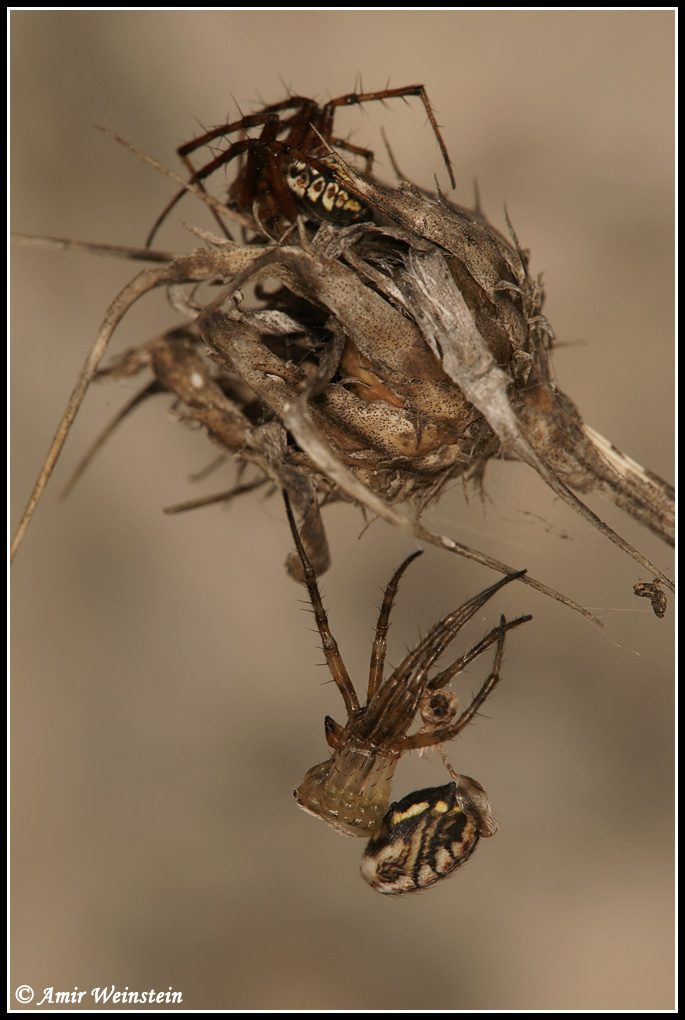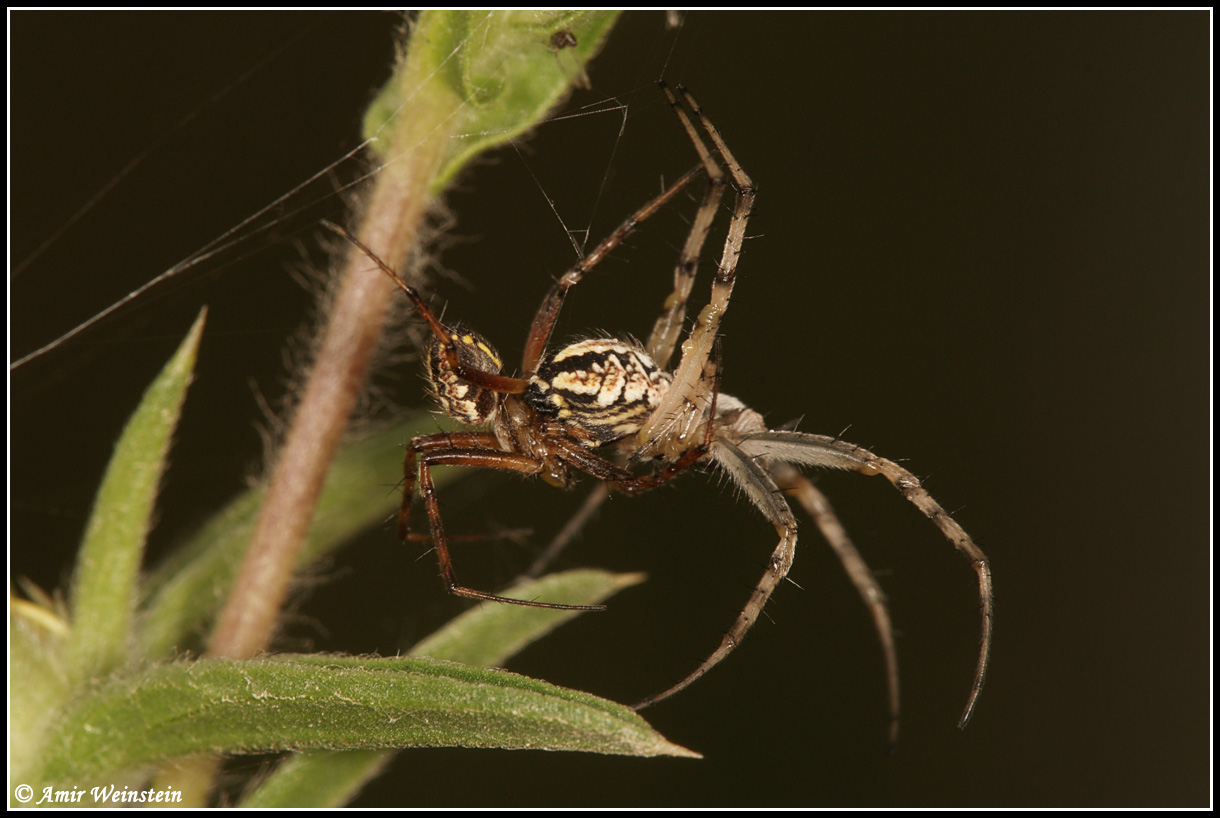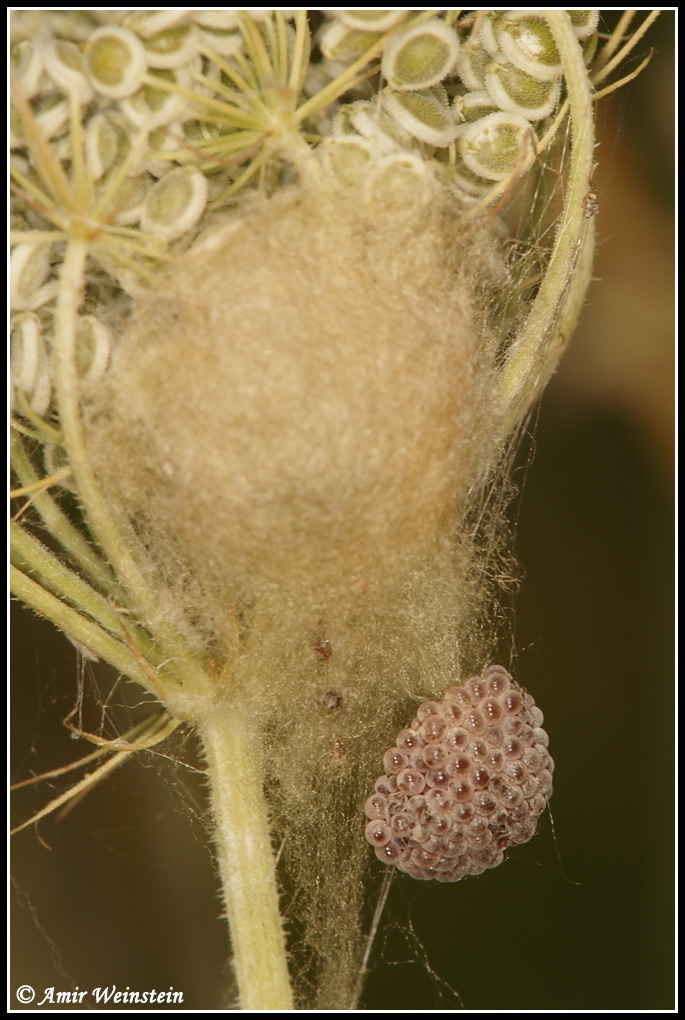|
|
|
|
|
Galleria Tassonomica
di
Natura Mediterraneo
|
|
|
| Autore |
 Discussione Discussione  |
|
|
Amir
Utente Senior
   

Città: Tel-Aviv
Regione: Israel

785 Messaggi
Tutti i Forum |
|
|
elleelle
Moderatore Trasversale
    
Città: roma
Regione: Lazio

33258 Messaggi
Flora e Fauna |
 Inserito il - 28 marzo 2010 : 13:24:31 Inserito il - 28 marzo 2010 : 13:24:31


|
A very good photo and a lucky strike!
About the name, I don't know the meaning of Neoscona, except for the obvious "neo = new", while "adianta" should mean that this species prefers xeric environmets, whit little humidity.
 luigi luigi
|
 |
|
|
Pepsis
Moderatore
    
Città: Roma

5036 Messaggi
Flora e Fauna |
 Inserito il - 28 marzo 2010 : 15:18:30 Inserito il - 28 marzo 2010 : 15:18:30


|
| Both are from Greek: Neoscona means "new dust", adianta means "dry places" |
 |
|
|
Amir
Utente Senior
   

Città: Tel-Aviv
Regione: Israel

785 Messaggi
Tutti i Forum |
 Inserito il - 29 marzo 2010 : 07:23:36 Inserito il - 29 marzo 2010 : 07:23:36


|
Grazie
An interesting explanation, still it's hard for me to understand what was in Walckenaer (1802) mind while he given the species name to this spider.
adding more 2 photos
The first show the male waiting in patience for the virgin female while she molting.
The second photo show (anther couple from same location) a "frustrated" male trying copulate. The female was trying avoid him most of the time.
Immagine:

168,88 KB
Immagine:

232,83 KB
my albums:
Link
My insects blog (Hebrew)
Link
Spiders Snapshots (English)
Link |
 |
|
|
Juventino
Utente Super
    
Città: Nizza
Regione: France

10135 Messaggi
Tutti i Forum |
 Inserito il - 29 marzo 2010 : 08:12:30 Inserito il - 29 marzo 2010 : 08:12:30


|
Beautiful photos!!!
Link
L’école buissonnière |
 |
|
|
elleelle
Moderatore Trasversale
    
Città: roma
Regione: Lazio

33258 Messaggi
Flora e Fauna |
 Inserito il - 29 marzo 2010 : 22:49:35 Inserito il - 29 marzo 2010 : 22:49:35


|
I agree with Catherine abuot the photos. 
As for the behaviour you have observed, sometimes males wait for the last molting of a female because only after it she will become sexually mature.
They stand waiting patiently because so they are shure to be the first.
But the female needs a little time for being mature; al least so far to get her skeleton dry and hard; what does not result of your last photo.
 luigi luigi |
 |
|
|
Lucarelli
Utente Senior
   

Città: Livorno
Prov.: Livorno
Regione: Toscana

577 Messaggi
Tutti i Forum |
 Inserito il - 30 marzo 2010 : 17:53:18 Inserito il - 30 marzo 2010 : 17:53:18


|
Ciao Amir,
beatiful photos, my compliments.
Regarding the name, I could find something with Google and Google books.
Walckenaer mentions the spider in Faune parisienne, insectes: Ou Histoire abrégée des insectes des environs de Paris (1802), on page 199 as Aranea adianta.
Link
Adianta comes from Greek and means “not wetting”, in this case it refers to Adiantum, genus of "Maidenhair ferns" (Link ), or ferns in general. The french trivial name of the spider is “fern spider”, adiante fougère (interesting that the German trivial name has another meaning; Heideradnetzspinne, where Heide means heath, heathlands or heath plants (Ericaceae)). ), or ferns in general. The french trivial name of the spider is “fern spider”, adiante fougère (interesting that the German trivial name has another meaning; Heideradnetzspinne, where Heide means heath, heathlands or heath plants (Ericaceae)).
The genus Neoscona was introduced by Eugène Simon; in his book Histoire naturelle des araignées (aranéides) he gives the following etymology (page 261)
Link
Neoscona (neo, filer; skoinos; roseau), that means Neo: to spin, to heap up, "bind together", Skoinos: something like reed or rush.
Saluti,
--- Lucarelli --- |
Modificato da - Lucarelli in data 30 marzo 2010 18:02:12 |
 |
|
|
Amir
Utente Senior
   

Città: Tel-Aviv
Regione: Israel

785 Messaggi
Tutti i Forum |
 Inserito il - 02 aprile 2010 : 06:41:08 Inserito il - 02 aprile 2010 : 06:41:08


|
ciao
Thanks to all
As to the "Neoscona", since it's referring the genus name and we r not sure which spider's species was first won the name, its hard to say how the meaning is related to the N.adianta behaves, if so.
Add a photo of an eggs sac, which attached to a Apiaceae inflorescence used by a big N. adianta female as web anchor.
Immagine:

274,08 KB
my albums:
Link
My insects blog (Hebrew)
Link
Spiders Snapshots (English)
Link |
 |
|
|
Amir
Utente Senior
   

Città: Tel-Aviv
Regione: Israel

785 Messaggi
Tutti i Forum |
 Inserito il - 03 aprile 2010 : 05:48:19 Inserito il - 03 aprile 2010 : 05:48:19


|
Hi
Here the eggs sac as it look from yesterday
Strangely the eggs cluster was hang outside (who open the sac?)
The female was not there (also the web go)
This is the only egg sac in the vicinity, there r many mature females around, but this is the only eggs sac I found there.
I'm still not sure its belong to Neoscona adianta. There is also Agalenatea redii 30 cm beside. who know?
Immagine:

227,8 KB
my albums:
Link
My insects blog (Hebrew)
Link
Spiders Snapshots (English)
Link |
 |
|
| |
 Discussione Discussione  |
|
|
|
 Natura Mediterraneo Natura Mediterraneo |
© 2003-2024 Natura Mediterraneo |
 |
|
Leps.it | Herp.it | Lynkos.net
|

 Forum
|
Registrati
|
Msg attivi
|
Msg Recenti
|
Msg Pvt
|
Utenti
|
Galleria |
Map |
Forum
|
Registrati
|
Msg attivi
|
Msg Recenti
|
Msg Pvt
|
Utenti
|
Galleria |
Map |